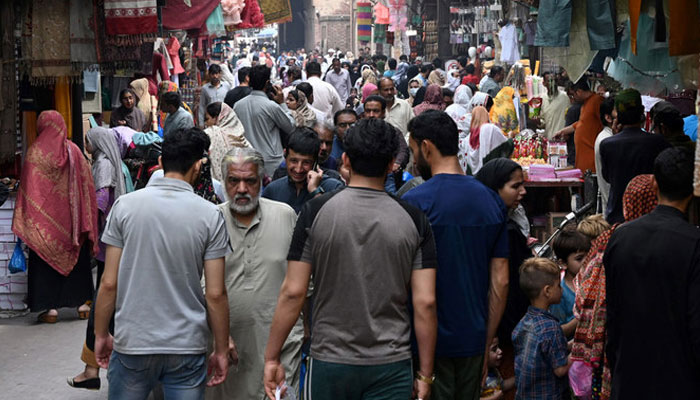Global fertility rates to decline, shifting population burden to low-income countries
The trend will lead to a “baby boom” and “baby bust” divide across the world
PARIS: Fertility rates in nearly all countries will be too low to sustain population levels by the end of the century, and most of the world’s live births will be occurring in poorer countries, according to a study published on Thursday.
The trend will lead to a “baby boom” and “baby bust” divide across the world, with the boom concentrated in low-income countries that are more susceptible to economic and political instability, senior researcher Stein Emil Vollset from the Institute for Health Metrics and Evaluation (IHME) at the University of Washington in Seattle said in a statement.
The study reported in The Lancet projects 155 of 204 countries and territories worldwide, or 76 percent, will have fertility rates below population replacement levels by 2050. By 2100, that is expected to rise to 198, or 97 percent, researchers estimated. The forecasts are based on surveys, censuses, and other sources of data collected from 1950 through 2021 as part of the Global Burden of Diseases, Injuries, and Risk Factors Study. Over three-quarters of live births will occur in low- and lower-middle-income countries by the end of the century, with more than half taking place in sub-Saharan Africa, researchers said.
The global fertility rate - the average number of births per woman - has fallen from around 5 children in 1950 to 2.2 in 2021, data show.
By 2021, 110 countries and territories (54 percent) had rates below the population replacement level of 2.1 children per woman.
The study highlights a particularly worrying trend for countries like South Korea and Serbia, where the fertility rate is less than 1.1 child per female, exposing them to challenges of a dwindling workforce. Many of the most resource-limited countries “will be grappling with how to support the youngest, fastest-growing population on the planet in some of the most politically and economically unstable, heat-stressed, and health system-strained places on earth,” Vollset said.
-
 Gaten Matarazzo On Unbreakable Bonds Of 'Stranger Things'
Gaten Matarazzo On Unbreakable Bonds Of 'Stranger Things' -
 Beyonce, Jay-Z's Daughter Blue Ivy Carter's Massive Fortune Taking Shape At 14?
Beyonce, Jay-Z's Daughter Blue Ivy Carter's Massive Fortune Taking Shape At 14? -
 Meghan Markle Fulfills Fan Wish As She Joins Viral 2106 Trend
Meghan Markle Fulfills Fan Wish As She Joins Viral 2106 Trend -
 Selena Gomez Proves Point With New Makeup-free Selfie On Social Media
Selena Gomez Proves Point With New Makeup-free Selfie On Social Media -
 John Mellencamp Shares Heartbreaking Side Effect Of Teddi's Cancer
John Mellencamp Shares Heartbreaking Side Effect Of Teddi's Cancer -
 Kate Middleton 'overjoyed' Over THIS News About Meghan Markle, Prince Harry
Kate Middleton 'overjoyed' Over THIS News About Meghan Markle, Prince Harry -
 'Harry Potter' Star Brendan Gleeson Reluctantly Addresses JK Rowling's Trans Views
'Harry Potter' Star Brendan Gleeson Reluctantly Addresses JK Rowling's Trans Views -
 Priscilla Presley Reveals The Path Elvis Would Have Taken If He Were Still Alive
Priscilla Presley Reveals The Path Elvis Would Have Taken If He Were Still Alive -
 Kianna Underwood's Death Marks Fourth Nickelodeon-related Loss In Weeks, 9th Since 2018
Kianna Underwood's Death Marks Fourth Nickelodeon-related Loss In Weeks, 9th Since 2018 -
 Hayden Christensen Makes Most Funny 'Star Wars' Confession Yet
Hayden Christensen Makes Most Funny 'Star Wars' Confession Yet -
 Subway Surfers City: Release Date, Exciting New Modes, And All The Big Changes Coming In 2026
Subway Surfers City: Release Date, Exciting New Modes, And All The Big Changes Coming In 2026 -
 Tom Ford's Brutal Behaviour With Ashton Kutcher Finally Exposed
Tom Ford's Brutal Behaviour With Ashton Kutcher Finally Exposed -
 Gaten Matarazzo Heaps Praise For Duffer Brothers
Gaten Matarazzo Heaps Praise For Duffer Brothers -
 Millions Of Bluetooth Earbuds At Risk Due To Google Fast Pair Flaw
Millions Of Bluetooth Earbuds At Risk Due To Google Fast Pair Flaw -
 Sarah Ferguson Believes 'royal Machine' Failed To Protect Her
Sarah Ferguson Believes 'royal Machine' Failed To Protect Her -
 'The Night Manager' Producer Proud To Guard Season Two Secret
'The Night Manager' Producer Proud To Guard Season Two Secret




